University Taxation Law Assignment: Capital Gains, Loans, and Property
VerifiedAdded on 2020/04/07
|9
|2787
|44
Homework Assignment
AI Summary
This assignment delves into various aspects of taxation law, providing a detailed analysis of capital gains, loan benefits, and property taxation. The student calculates net capital gains or losses, considering assets like a home sound system, shares, and collectibles. The assignment also examines loan incidental benefits, determining assessable values and deductible interest costs. Furthermore, it explores property taxation, outlining how losses are allocated between parties and the implications of tax avoidance strategies. The analysis includes supporting evidence, critical analysis, and conclusions for each scenario, providing a comprehensive understanding of tax treatment in different situations.
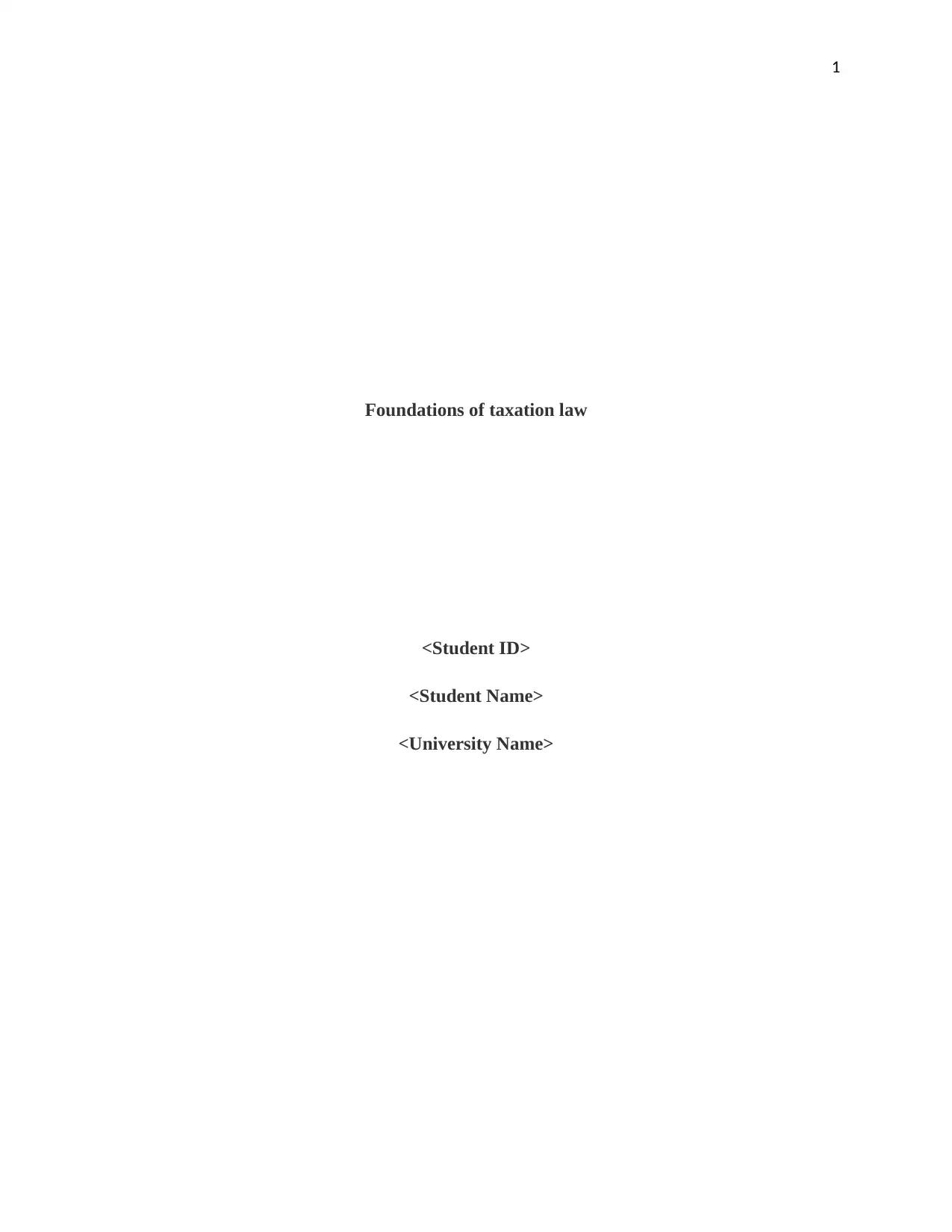
1
Foundations of taxation law
<Student ID>
<Student Name>
<University Name>
Foundations of taxation law
<Student ID>
<Student Name>
<University Name>
Paraphrase This Document
Need a fresh take? Get an instant paraphrase of this document with our AI Paraphraser
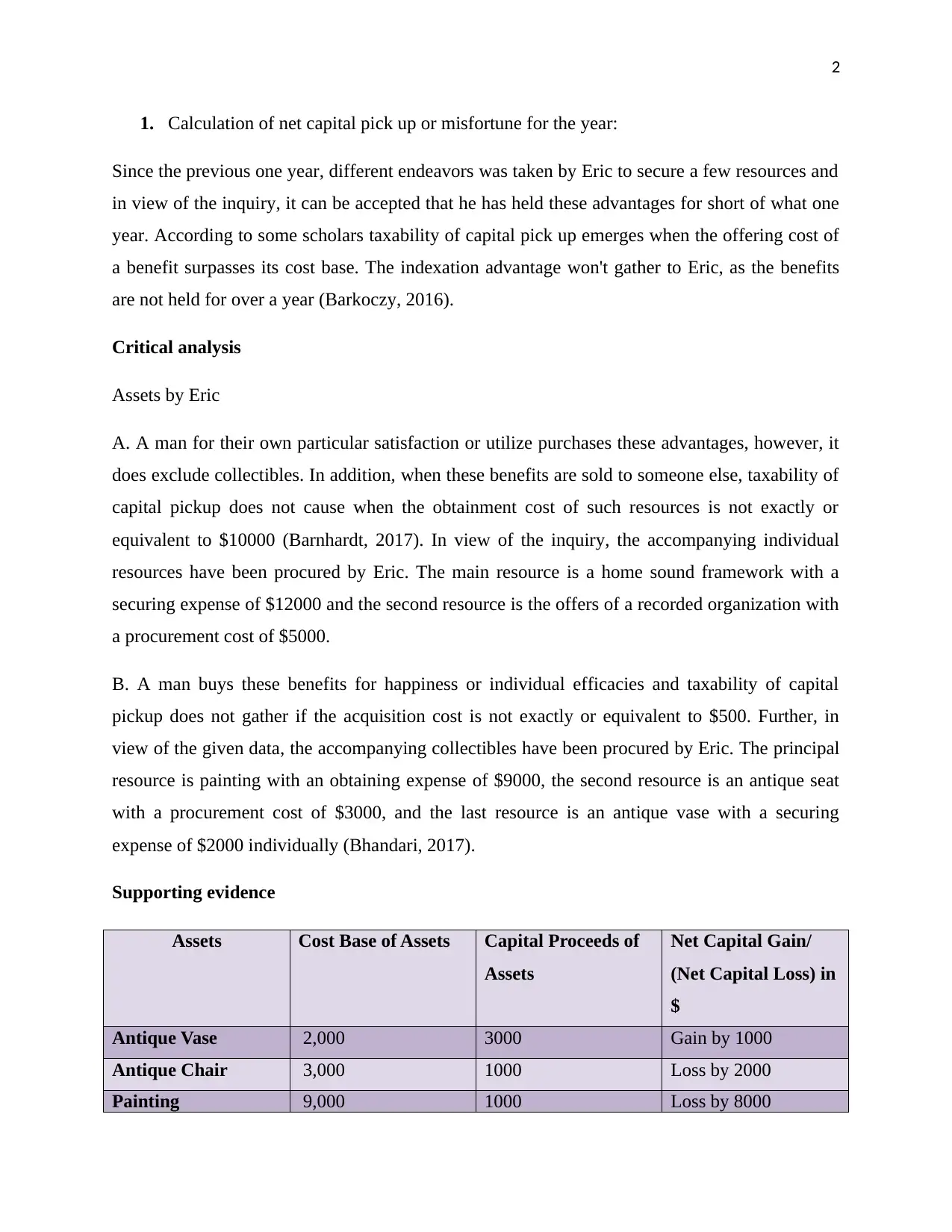
2
1. Calculation of net capital pick up or misfortune for the year:
Since the previous one year, different endeavors was taken by Eric to secure a few resources and
in view of the inquiry, it can be accepted that he has held these advantages for short of what one
year. According to some scholars taxability of capital pick up emerges when the offering cost of
a benefit surpasses its cost base. The indexation advantage won't gather to Eric, as the benefits
are not held for over a year (Barkoczy, 2016).
Critical analysis
Assets by Eric
A. A man for their own particular satisfaction or utilize purchases these advantages, however, it
does exclude collectibles. In addition, when these benefits are sold to someone else, taxability of
capital pickup does not cause when the obtainment cost of such resources is not exactly or
equivalent to $10000 (Barnhardt, 2017). In view of the inquiry, the accompanying individual
resources have been procured by Eric. The main resource is a home sound framework with a
securing expense of $12000 and the second resource is the offers of a recorded organization with
a procurement cost of $5000.
B. A man buys these benefits for happiness or individual efficacies and taxability of capital
pickup does not gather if the acquisition cost is not exactly or equivalent to $500. Further, in
view of the given data, the accompanying collectibles have been procured by Eric. The principal
resource is painting with an obtaining expense of $9000, the second resource is an antique seat
with a procurement cost of $3000, and the last resource is an antique vase with a securing
expense of $2000 individually (Bhandari, 2017).
Supporting evidence
Assets Cost Base of Assets Capital Proceeds of
Assets
Net Capital Gain/
(Net Capital Loss) in
$
Antique Vase 2,000 3000 Gain by 1000
Antique Chair 3,000 1000 Loss by 2000
Painting 9,000 1000 Loss by 8000
1. Calculation of net capital pick up or misfortune for the year:
Since the previous one year, different endeavors was taken by Eric to secure a few resources and
in view of the inquiry, it can be accepted that he has held these advantages for short of what one
year. According to some scholars taxability of capital pick up emerges when the offering cost of
a benefit surpasses its cost base. The indexation advantage won't gather to Eric, as the benefits
are not held for over a year (Barkoczy, 2016).
Critical analysis
Assets by Eric
A. A man for their own particular satisfaction or utilize purchases these advantages, however, it
does exclude collectibles. In addition, when these benefits are sold to someone else, taxability of
capital pickup does not cause when the obtainment cost of such resources is not exactly or
equivalent to $10000 (Barnhardt, 2017). In view of the inquiry, the accompanying individual
resources have been procured by Eric. The main resource is a home sound framework with a
securing expense of $12000 and the second resource is the offers of a recorded organization with
a procurement cost of $5000.
B. A man buys these benefits for happiness or individual efficacies and taxability of capital
pickup does not gather if the acquisition cost is not exactly or equivalent to $500. Further, in
view of the given data, the accompanying collectibles have been procured by Eric. The principal
resource is painting with an obtaining expense of $9000, the second resource is an antique seat
with a procurement cost of $3000, and the last resource is an antique vase with a securing
expense of $2000 individually (Bhandari, 2017).
Supporting evidence
Assets Cost Base of Assets Capital Proceeds of
Assets
Net Capital Gain/
(Net Capital Loss) in
$
Antique Vase 2,000 3000 Gain by 1000
Antique Chair 3,000 1000 Loss by 2000
Painting 9,000 1000 Loss by 8000
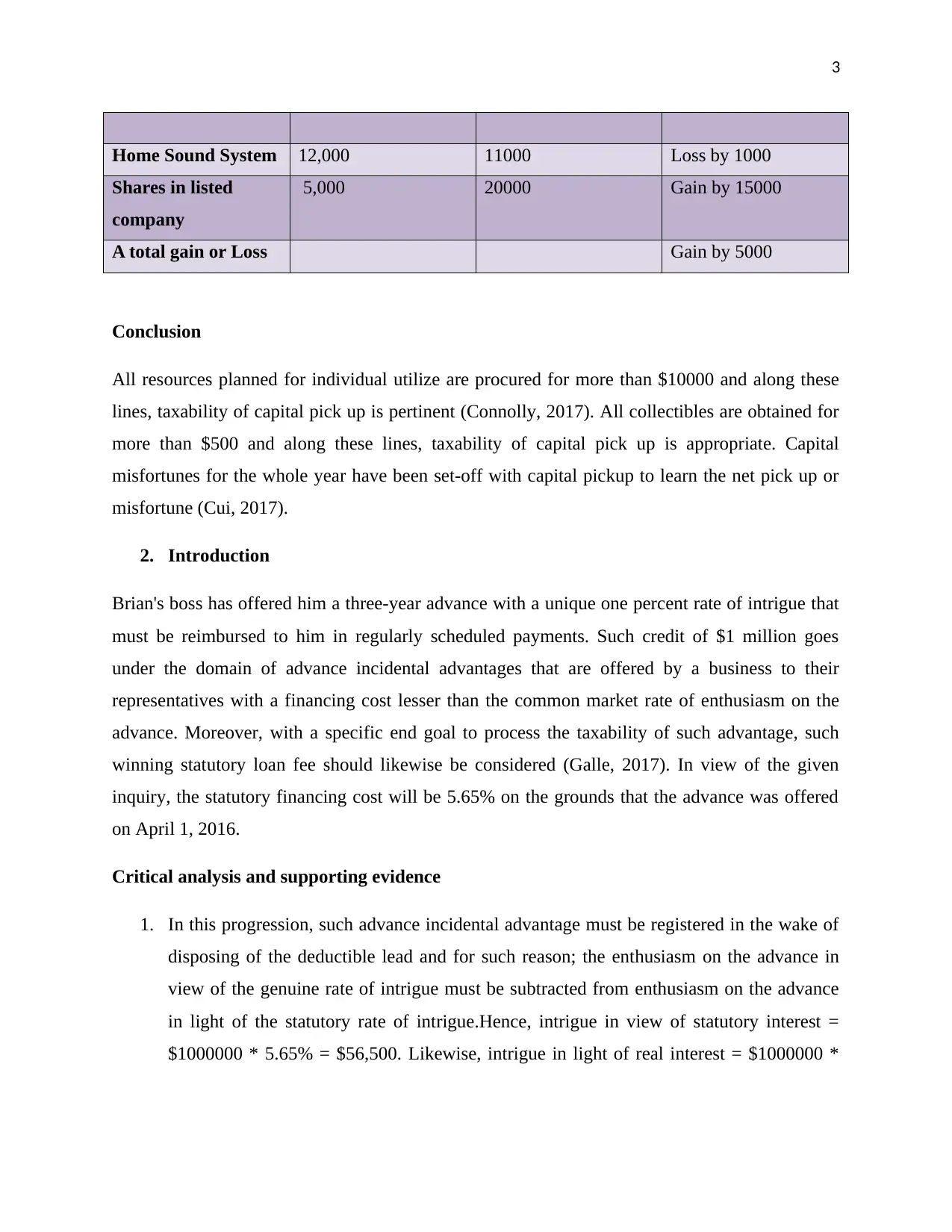
3
Home Sound System 12,000 11000 Loss by 1000
Shares in listed
company
5,000 20000 Gain by 15000
A total gain or Loss Gain by 5000
Conclusion
All resources planned for individual utilize are procured for more than $10000 and along these
lines, taxability of capital pick up is pertinent (Connolly, 2017). All collectibles are obtained for
more than $500 and along these lines, taxability of capital pick up is appropriate. Capital
misfortunes for the whole year have been set-off with capital pickup to learn the net pick up or
misfortune (Cui, 2017).
2. Introduction
Brian's boss has offered him a three-year advance with a unique one percent rate of intrigue that
must be reimbursed to him in regularly scheduled payments. Such credit of $1 million goes
under the domain of advance incidental advantages that are offered by a business to their
representatives with a financing cost lesser than the common market rate of enthusiasm on the
advance. Moreover, with a specific end goal to process the taxability of such advantage, such
winning statutory loan fee should likewise be considered (Galle, 2017). In view of the given
inquiry, the statutory financing cost will be 5.65% on the grounds that the advance was offered
on April 1, 2016.
Critical analysis and supporting evidence
1. In this progression, such advance incidental advantage must be registered in the wake of
disposing of the deductible lead and for such reason; the enthusiasm on the advance in
view of the genuine rate of intrigue must be subtracted from enthusiasm on the advance
in light of the statutory rate of intrigue.Hence, intrigue in view of statutory interest =
$1000000 * 5.65% = $56,500. Likewise, intrigue in light of real interest = $1000000 *
Home Sound System 12,000 11000 Loss by 1000
Shares in listed
company
5,000 20000 Gain by 15000
A total gain or Loss Gain by 5000
Conclusion
All resources planned for individual utilize are procured for more than $10000 and along these
lines, taxability of capital pick up is pertinent (Connolly, 2017). All collectibles are obtained for
more than $500 and along these lines, taxability of capital pick up is appropriate. Capital
misfortunes for the whole year have been set-off with capital pickup to learn the net pick up or
misfortune (Cui, 2017).
2. Introduction
Brian's boss has offered him a three-year advance with a unique one percent rate of intrigue that
must be reimbursed to him in regularly scheduled payments. Such credit of $1 million goes
under the domain of advance incidental advantages that are offered by a business to their
representatives with a financing cost lesser than the common market rate of enthusiasm on the
advance. Moreover, with a specific end goal to process the taxability of such advantage, such
winning statutory loan fee should likewise be considered (Galle, 2017). In view of the given
inquiry, the statutory financing cost will be 5.65% on the grounds that the advance was offered
on April 1, 2016.
Critical analysis and supporting evidence
1. In this progression, such advance incidental advantage must be registered in the wake of
disposing of the deductible lead and for such reason; the enthusiasm on the advance in
view of the genuine rate of intrigue must be subtracted from enthusiasm on the advance
in light of the statutory rate of intrigue.Hence, intrigue in view of statutory interest =
$1000000 * 5.65% = $56,500. Likewise, intrigue in light of real interest = $1000000 *
⊘ This is a preview!⊘
Do you want full access?
Subscribe today to unlock all pages.

Trusted by 1+ million students worldwide
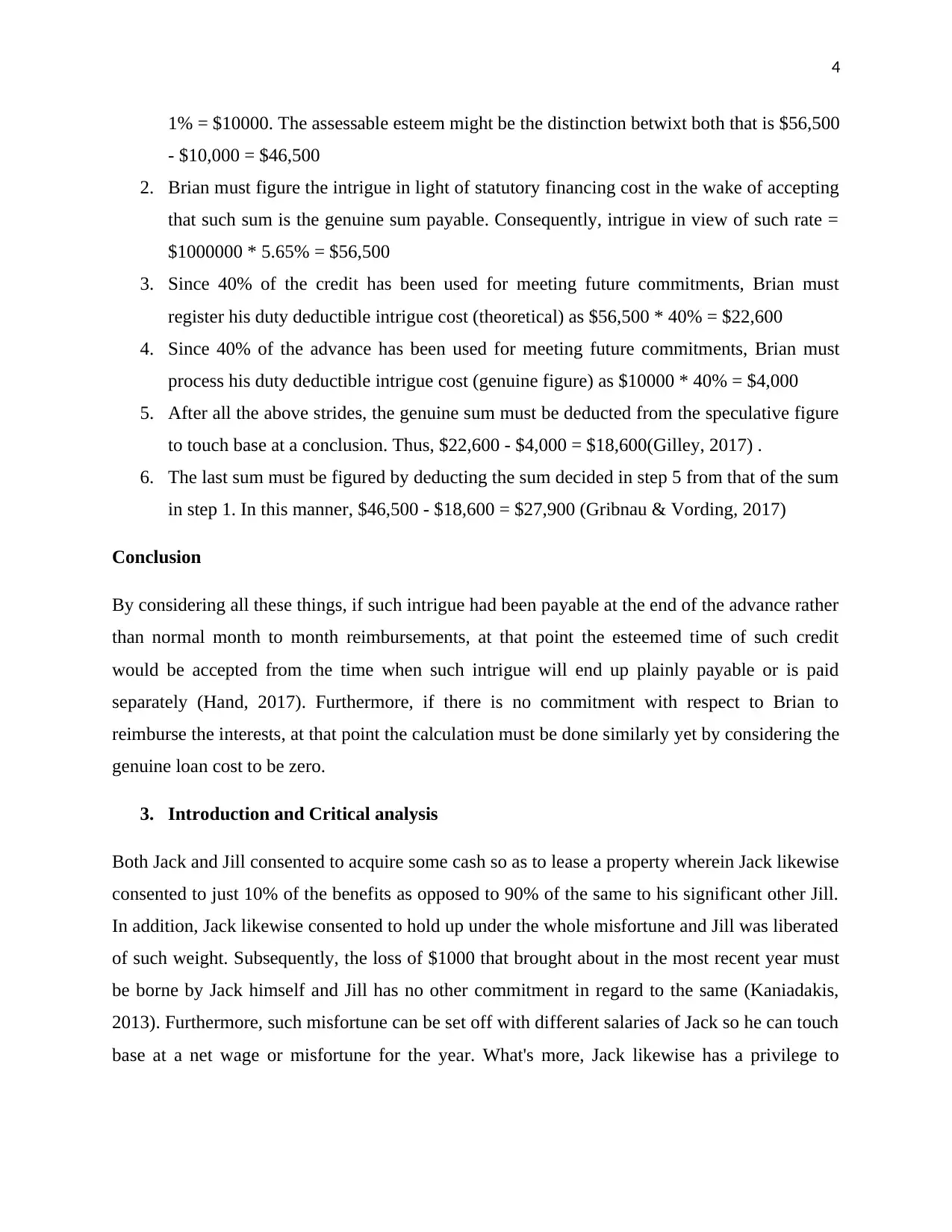
4
1% = $10000. The assessable esteem might be the distinction betwixt both that is $56,500
- $10,000 = $46,500
2. Brian must figure the intrigue in light of statutory financing cost in the wake of accepting
that such sum is the genuine sum payable. Consequently, intrigue in view of such rate =
$1000000 * 5.65% = $56,500
3. Since 40% of the credit has been used for meeting future commitments, Brian must
register his duty deductible intrigue cost (theoretical) as $56,500 * 40% = $22,600
4. Since 40% of the advance has been used for meeting future commitments, Brian must
process his duty deductible intrigue cost (genuine figure) as $10000 * 40% = $4,000
5. After all the above strides, the genuine sum must be deducted from the speculative figure
to touch base at a conclusion. Thus, $22,600 - $4,000 = $18,600(Gilley, 2017) .
6. The last sum must be figured by deducting the sum decided in step 5 from that of the sum
in step 1. In this manner, $46,500 - $18,600 = $27,900 (Gribnau & Vording, 2017)
Conclusion
By considering all these things, if such intrigue had been payable at the end of the advance rather
than normal month to month reimbursements, at that point the esteemed time of such credit
would be accepted from the time when such intrigue will end up plainly payable or is paid
separately (Hand, 2017). Furthermore, if there is no commitment with respect to Brian to
reimburse the interests, at that point the calculation must be done similarly yet by considering the
genuine loan cost to be zero.
3. Introduction and Critical analysis
Both Jack and Jill consented to acquire some cash so as to lease a property wherein Jack likewise
consented to just 10% of the benefits as opposed to 90% of the same to his significant other Jill.
In addition, Jack likewise consented to hold up under the whole misfortune and Jill was liberated
of such weight. Subsequently, the loss of $1000 that brought about in the most recent year must
be borne by Jack himself and Jill has no other commitment in regard to the same (Kaniadakis,
2013). Furthermore, such misfortune can be set off with different salaries of Jack so he can touch
base at a net wage or misfortune for the year. What's more, Jack likewise has a privilege to
1% = $10000. The assessable esteem might be the distinction betwixt both that is $56,500
- $10,000 = $46,500
2. Brian must figure the intrigue in light of statutory financing cost in the wake of accepting
that such sum is the genuine sum payable. Consequently, intrigue in view of such rate =
$1000000 * 5.65% = $56,500
3. Since 40% of the credit has been used for meeting future commitments, Brian must
register his duty deductible intrigue cost (theoretical) as $56,500 * 40% = $22,600
4. Since 40% of the advance has been used for meeting future commitments, Brian must
process his duty deductible intrigue cost (genuine figure) as $10000 * 40% = $4,000
5. After all the above strides, the genuine sum must be deducted from the speculative figure
to touch base at a conclusion. Thus, $22,600 - $4,000 = $18,600(Gilley, 2017) .
6. The last sum must be figured by deducting the sum decided in step 5 from that of the sum
in step 1. In this manner, $46,500 - $18,600 = $27,900 (Gribnau & Vording, 2017)
Conclusion
By considering all these things, if such intrigue had been payable at the end of the advance rather
than normal month to month reimbursements, at that point the esteemed time of such credit
would be accepted from the time when such intrigue will end up plainly payable or is paid
separately (Hand, 2017). Furthermore, if there is no commitment with respect to Brian to
reimburse the interests, at that point the calculation must be done similarly yet by considering the
genuine loan cost to be zero.
3. Introduction and Critical analysis
Both Jack and Jill consented to acquire some cash so as to lease a property wherein Jack likewise
consented to just 10% of the benefits as opposed to 90% of the same to his significant other Jill.
In addition, Jack likewise consented to hold up under the whole misfortune and Jill was liberated
of such weight. Subsequently, the loss of $1000 that brought about in the most recent year must
be borne by Jack himself and Jill has no other commitment in regard to the same (Kaniadakis,
2013). Furthermore, such misfortune can be set off with different salaries of Jack so he can touch
base at a net wage or misfortune for the year. What's more, Jack likewise has a privilege to
Paraphrase This Document
Need a fresh take? Get an instant paraphrase of this document with our AI Paraphraser
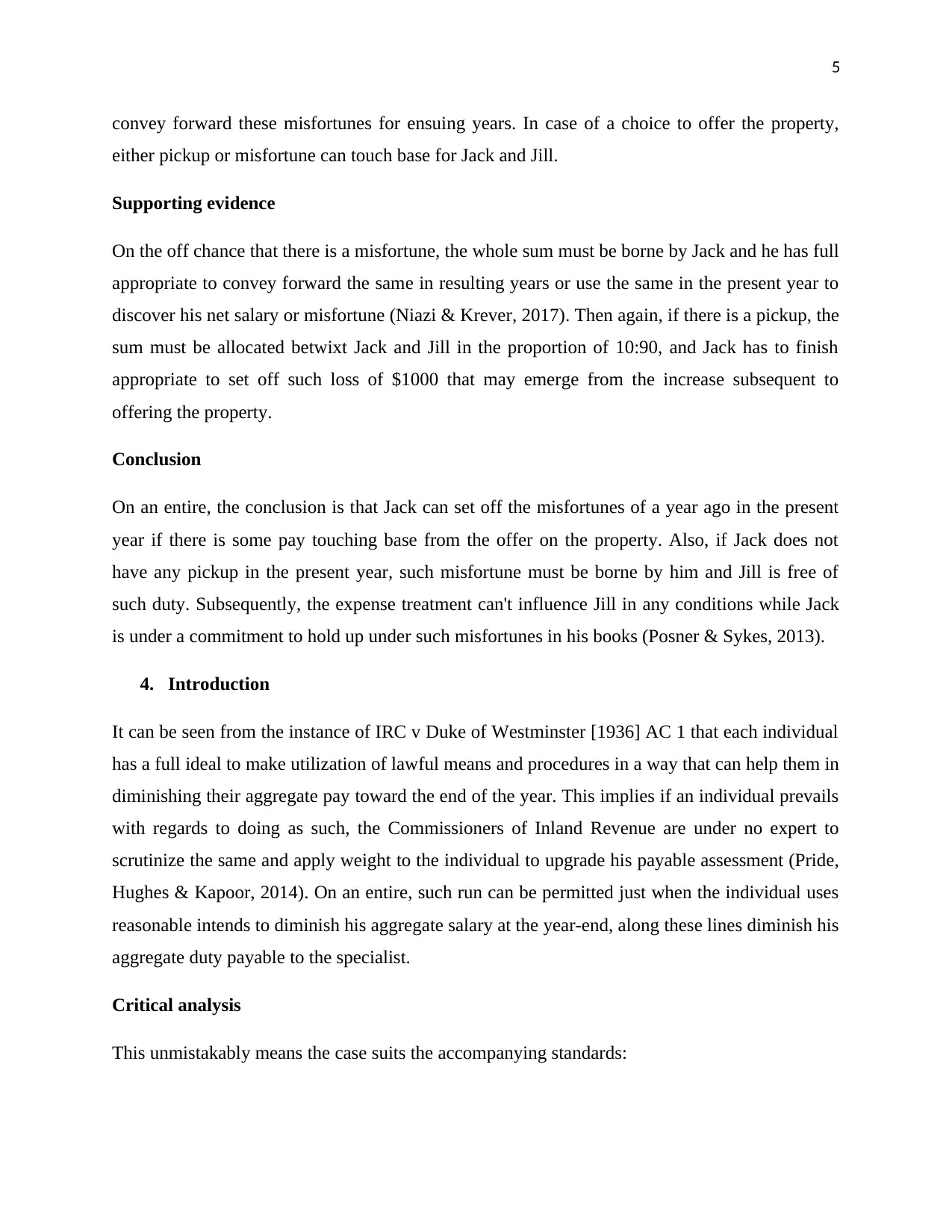
5
convey forward these misfortunes for ensuing years. In case of a choice to offer the property,
either pickup or misfortune can touch base for Jack and Jill.
Supporting evidence
On the off chance that there is a misfortune, the whole sum must be borne by Jack and he has full
appropriate to convey forward the same in resulting years or use the same in the present year to
discover his net salary or misfortune (Niazi & Krever, 2017). Then again, if there is a pickup, the
sum must be allocated betwixt Jack and Jill in the proportion of 10:90, and Jack has to finish
appropriate to set off such loss of $1000 that may emerge from the increase subsequent to
offering the property.
Conclusion
On an entire, the conclusion is that Jack can set off the misfortunes of a year ago in the present
year if there is some pay touching base from the offer on the property. Also, if Jack does not
have any pickup in the present year, such misfortune must be borne by him and Jill is free of
such duty. Subsequently, the expense treatment can't influence Jill in any conditions while Jack
is under a commitment to hold up under such misfortunes in his books (Posner & Sykes, 2013).
4. Introduction
It can be seen from the instance of IRC v Duke of Westminster [1936] AC 1 that each individual
has a full ideal to make utilization of lawful means and procedures in a way that can help them in
diminishing their aggregate pay toward the end of the year. This implies if an individual prevails
with regards to doing as such, the Commissioners of Inland Revenue are under no expert to
scrutinize the same and apply weight to the individual to upgrade his payable assessment (Pride,
Hughes & Kapoor, 2014). On an entire, such run can be permitted just when the individual uses
reasonable intends to diminish his aggregate salary at the year-end, along these lines diminish his
aggregate duty payable to the specialist.
Critical analysis
This unmistakably means the case suits the accompanying standards:
convey forward these misfortunes for ensuing years. In case of a choice to offer the property,
either pickup or misfortune can touch base for Jack and Jill.
Supporting evidence
On the off chance that there is a misfortune, the whole sum must be borne by Jack and he has full
appropriate to convey forward the same in resulting years or use the same in the present year to
discover his net salary or misfortune (Niazi & Krever, 2017). Then again, if there is a pickup, the
sum must be allocated betwixt Jack and Jill in the proportion of 10:90, and Jack has to finish
appropriate to set off such loss of $1000 that may emerge from the increase subsequent to
offering the property.
Conclusion
On an entire, the conclusion is that Jack can set off the misfortunes of a year ago in the present
year if there is some pay touching base from the offer on the property. Also, if Jack does not
have any pickup in the present year, such misfortune must be borne by him and Jill is free of
such duty. Subsequently, the expense treatment can't influence Jill in any conditions while Jack
is under a commitment to hold up under such misfortunes in his books (Posner & Sykes, 2013).
4. Introduction
It can be seen from the instance of IRC v Duke of Westminster [1936] AC 1 that each individual
has a full ideal to make utilization of lawful means and procedures in a way that can help them in
diminishing their aggregate pay toward the end of the year. This implies if an individual prevails
with regards to doing as such, the Commissioners of Inland Revenue are under no expert to
scrutinize the same and apply weight to the individual to upgrade his payable assessment (Pride,
Hughes & Kapoor, 2014). On an entire, such run can be permitted just when the individual uses
reasonable intends to diminish his aggregate salary at the year-end, along these lines diminish his
aggregate duty payable to the specialist.
Critical analysis
This unmistakably means the case suits the accompanying standards:
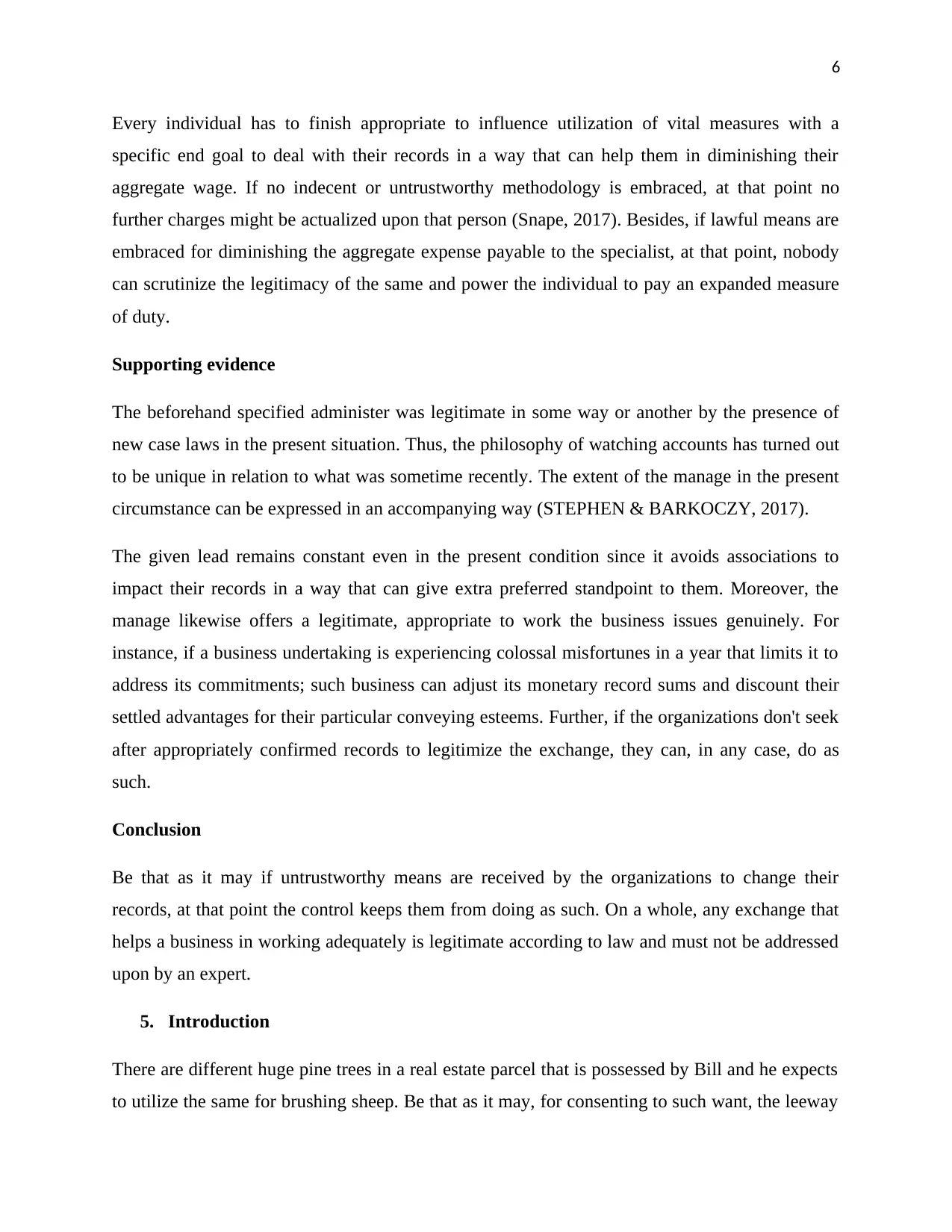
6
Every individual has to finish appropriate to influence utilization of vital measures with a
specific end goal to deal with their records in a way that can help them in diminishing their
aggregate wage. If no indecent or untrustworthy methodology is embraced, at that point no
further charges might be actualized upon that person (Snape, 2017). Besides, if lawful means are
embraced for diminishing the aggregate expense payable to the specialist, at that point, nobody
can scrutinize the legitimacy of the same and power the individual to pay an expanded measure
of duty.
Supporting evidence
The beforehand specified administer was legitimate in some way or another by the presence of
new case laws in the present situation. Thus, the philosophy of watching accounts has turned out
to be unique in relation to what was sometime recently. The extent of the manage in the present
circumstance can be expressed in an accompanying way (STEPHEN & BARKOCZY, 2017).
The given lead remains constant even in the present condition since it avoids associations to
impact their records in a way that can give extra preferred standpoint to them. Moreover, the
manage likewise offers a legitimate, appropriate to work the business issues genuinely. For
instance, if a business undertaking is experiencing colossal misfortunes in a year that limits it to
address its commitments; such business can adjust its monetary record sums and discount their
settled advantages for their particular conveying esteems. Further, if the organizations don't seek
after appropriately confirmed records to legitimize the exchange, they can, in any case, do as
such.
Conclusion
Be that as it may if untrustworthy means are received by the organizations to change their
records, at that point the control keeps them from doing as such. On a whole, any exchange that
helps a business in working adequately is legitimate according to law and must not be addressed
upon by an expert.
5. Introduction
There are different huge pine trees in a real estate parcel that is possessed by Bill and he expects
to utilize the same for brushing sheep. Be that as it may, for consenting to such want, the leeway
Every individual has to finish appropriate to influence utilization of vital measures with a
specific end goal to deal with their records in a way that can help them in diminishing their
aggregate wage. If no indecent or untrustworthy methodology is embraced, at that point no
further charges might be actualized upon that person (Snape, 2017). Besides, if lawful means are
embraced for diminishing the aggregate expense payable to the specialist, at that point, nobody
can scrutinize the legitimacy of the same and power the individual to pay an expanded measure
of duty.
Supporting evidence
The beforehand specified administer was legitimate in some way or another by the presence of
new case laws in the present situation. Thus, the philosophy of watching accounts has turned out
to be unique in relation to what was sometime recently. The extent of the manage in the present
circumstance can be expressed in an accompanying way (STEPHEN & BARKOCZY, 2017).
The given lead remains constant even in the present condition since it avoids associations to
impact their records in a way that can give extra preferred standpoint to them. Moreover, the
manage likewise offers a legitimate, appropriate to work the business issues genuinely. For
instance, if a business undertaking is experiencing colossal misfortunes in a year that limits it to
address its commitments; such business can adjust its monetary record sums and discount their
settled advantages for their particular conveying esteems. Further, if the organizations don't seek
after appropriately confirmed records to legitimize the exchange, they can, in any case, do as
such.
Conclusion
Be that as it may if untrustworthy means are received by the organizations to change their
records, at that point the control keeps them from doing as such. On a whole, any exchange that
helps a business in working adequately is legitimate according to law and must not be addressed
upon by an expert.
5. Introduction
There are different huge pine trees in a real estate parcel that is possessed by Bill and he expects
to utilize the same for brushing sheep. Be that as it may, for consenting to such want, the leeway
⊘ This is a preview!⊘
Do you want full access?
Subscribe today to unlock all pages.

Trusted by 1+ million students worldwide
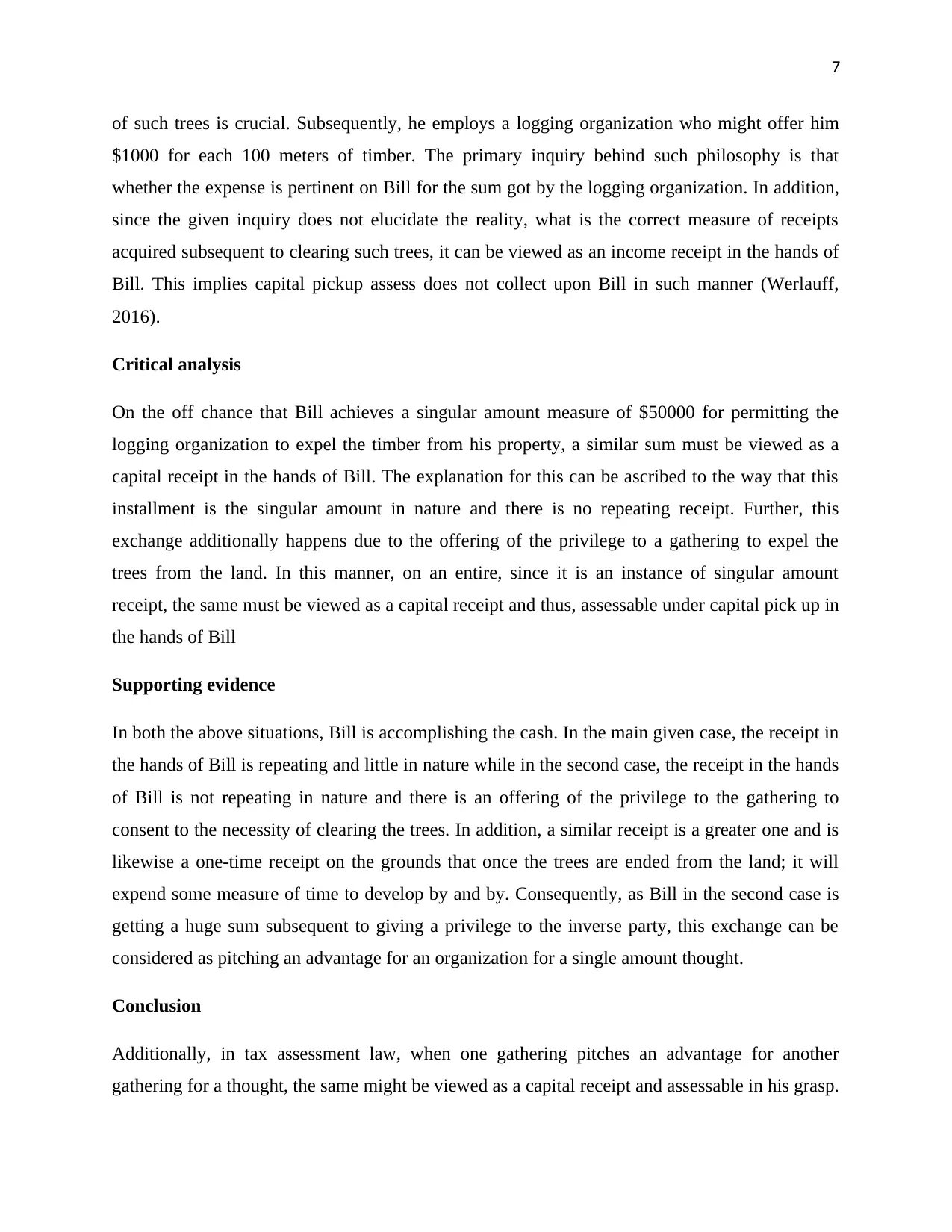
7
of such trees is crucial. Subsequently, he employs a logging organization who might offer him
$1000 for each 100 meters of timber. The primary inquiry behind such philosophy is that
whether the expense is pertinent on Bill for the sum got by the logging organization. In addition,
since the given inquiry does not elucidate the reality, what is the correct measure of receipts
acquired subsequent to clearing such trees, it can be viewed as an income receipt in the hands of
Bill. This implies capital pickup assess does not collect upon Bill in such manner (Werlauff,
2016).
Critical analysis
On the off chance that Bill achieves a singular amount measure of $50000 for permitting the
logging organization to expel the timber from his property, a similar sum must be viewed as a
capital receipt in the hands of Bill. The explanation for this can be ascribed to the way that this
installment is the singular amount in nature and there is no repeating receipt. Further, this
exchange additionally happens due to the offering of the privilege to a gathering to expel the
trees from the land. In this manner, on an entire, since it is an instance of singular amount
receipt, the same must be viewed as a capital receipt and thus, assessable under capital pick up in
the hands of Bill
Supporting evidence
In both the above situations, Bill is accomplishing the cash. In the main given case, the receipt in
the hands of Bill is repeating and little in nature while in the second case, the receipt in the hands
of Bill is not repeating in nature and there is an offering of the privilege to the gathering to
consent to the necessity of clearing the trees. In addition, a similar receipt is a greater one and is
likewise a one-time receipt on the grounds that once the trees are ended from the land; it will
expend some measure of time to develop by and by. Consequently, as Bill in the second case is
getting a huge sum subsequent to giving a privilege to the inverse party, this exchange can be
considered as pitching an advantage for an organization for a single amount thought.
Conclusion
Additionally, in tax assessment law, when one gathering pitches an advantage for another
gathering for a thought, the same might be viewed as a capital receipt and assessable in his grasp.
of such trees is crucial. Subsequently, he employs a logging organization who might offer him
$1000 for each 100 meters of timber. The primary inquiry behind such philosophy is that
whether the expense is pertinent on Bill for the sum got by the logging organization. In addition,
since the given inquiry does not elucidate the reality, what is the correct measure of receipts
acquired subsequent to clearing such trees, it can be viewed as an income receipt in the hands of
Bill. This implies capital pickup assess does not collect upon Bill in such manner (Werlauff,
2016).
Critical analysis
On the off chance that Bill achieves a singular amount measure of $50000 for permitting the
logging organization to expel the timber from his property, a similar sum must be viewed as a
capital receipt in the hands of Bill. The explanation for this can be ascribed to the way that this
installment is the singular amount in nature and there is no repeating receipt. Further, this
exchange additionally happens due to the offering of the privilege to a gathering to expel the
trees from the land. In this manner, on an entire, since it is an instance of singular amount
receipt, the same must be viewed as a capital receipt and thus, assessable under capital pick up in
the hands of Bill
Supporting evidence
In both the above situations, Bill is accomplishing the cash. In the main given case, the receipt in
the hands of Bill is repeating and little in nature while in the second case, the receipt in the hands
of Bill is not repeating in nature and there is an offering of the privilege to the gathering to
consent to the necessity of clearing the trees. In addition, a similar receipt is a greater one and is
likewise a one-time receipt on the grounds that once the trees are ended from the land; it will
expend some measure of time to develop by and by. Consequently, as Bill in the second case is
getting a huge sum subsequent to giving a privilege to the inverse party, this exchange can be
considered as pitching an advantage for an organization for a single amount thought.
Conclusion
Additionally, in tax assessment law, when one gathering pitches an advantage for another
gathering for a thought, the same might be viewed as a capital receipt and assessable in his grasp.
Paraphrase This Document
Need a fresh take? Get an instant paraphrase of this document with our AI Paraphraser
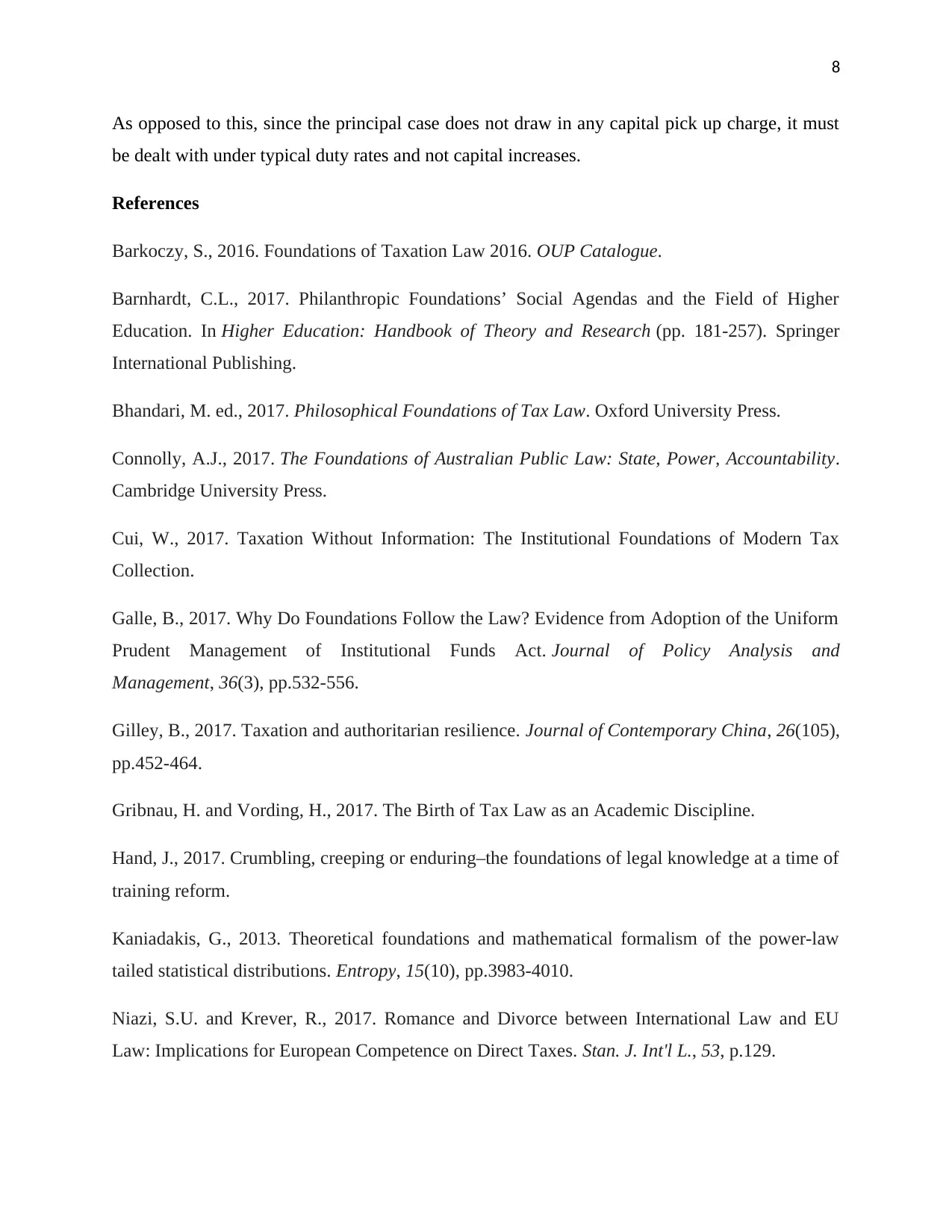
8
As opposed to this, since the principal case does not draw in any capital pick up charge, it must
be dealt with under typical duty rates and not capital increases.
References
Barkoczy, S., 2016. Foundations of Taxation Law 2016. OUP Catalogue.
Barnhardt, C.L., 2017. Philanthropic Foundations’ Social Agendas and the Field of Higher
Education. In Higher Education: Handbook of Theory and Research (pp. 181-257). Springer
International Publishing.
Bhandari, M. ed., 2017. Philosophical Foundations of Tax Law. Oxford University Press.
Connolly, A.J., 2017. The Foundations of Australian Public Law: State, Power, Accountability.
Cambridge University Press.
Cui, W., 2017. Taxation Without Information: The Institutional Foundations of Modern Tax
Collection.
Galle, B., 2017. Why Do Foundations Follow the Law? Evidence from Adoption of the Uniform
Prudent Management of Institutional Funds Act. Journal of Policy Analysis and
Management, 36(3), pp.532-556.
Gilley, B., 2017. Taxation and authoritarian resilience. Journal of Contemporary China, 26(105),
pp.452-464.
Gribnau, H. and Vording, H., 2017. The Birth of Tax Law as an Academic Discipline.
Hand, J., 2017. Crumbling, creeping or enduring–the foundations of legal knowledge at a time of
training reform.
Kaniadakis, G., 2013. Theoretical foundations and mathematical formalism of the power-law
tailed statistical distributions. Entropy, 15(10), pp.3983-4010.
Niazi, S.U. and Krever, R., 2017. Romance and Divorce between International Law and EU
Law: Implications for European Competence on Direct Taxes. Stan. J. Int'l L., 53, p.129.
As opposed to this, since the principal case does not draw in any capital pick up charge, it must
be dealt with under typical duty rates and not capital increases.
References
Barkoczy, S., 2016. Foundations of Taxation Law 2016. OUP Catalogue.
Barnhardt, C.L., 2017. Philanthropic Foundations’ Social Agendas and the Field of Higher
Education. In Higher Education: Handbook of Theory and Research (pp. 181-257). Springer
International Publishing.
Bhandari, M. ed., 2017. Philosophical Foundations of Tax Law. Oxford University Press.
Connolly, A.J., 2017. The Foundations of Australian Public Law: State, Power, Accountability.
Cambridge University Press.
Cui, W., 2017. Taxation Without Information: The Institutional Foundations of Modern Tax
Collection.
Galle, B., 2017. Why Do Foundations Follow the Law? Evidence from Adoption of the Uniform
Prudent Management of Institutional Funds Act. Journal of Policy Analysis and
Management, 36(3), pp.532-556.
Gilley, B., 2017. Taxation and authoritarian resilience. Journal of Contemporary China, 26(105),
pp.452-464.
Gribnau, H. and Vording, H., 2017. The Birth of Tax Law as an Academic Discipline.
Hand, J., 2017. Crumbling, creeping or enduring–the foundations of legal knowledge at a time of
training reform.
Kaniadakis, G., 2013. Theoretical foundations and mathematical formalism of the power-law
tailed statistical distributions. Entropy, 15(10), pp.3983-4010.
Niazi, S.U. and Krever, R., 2017. Romance and Divorce between International Law and EU
Law: Implications for European Competence on Direct Taxes. Stan. J. Int'l L., 53, p.129.
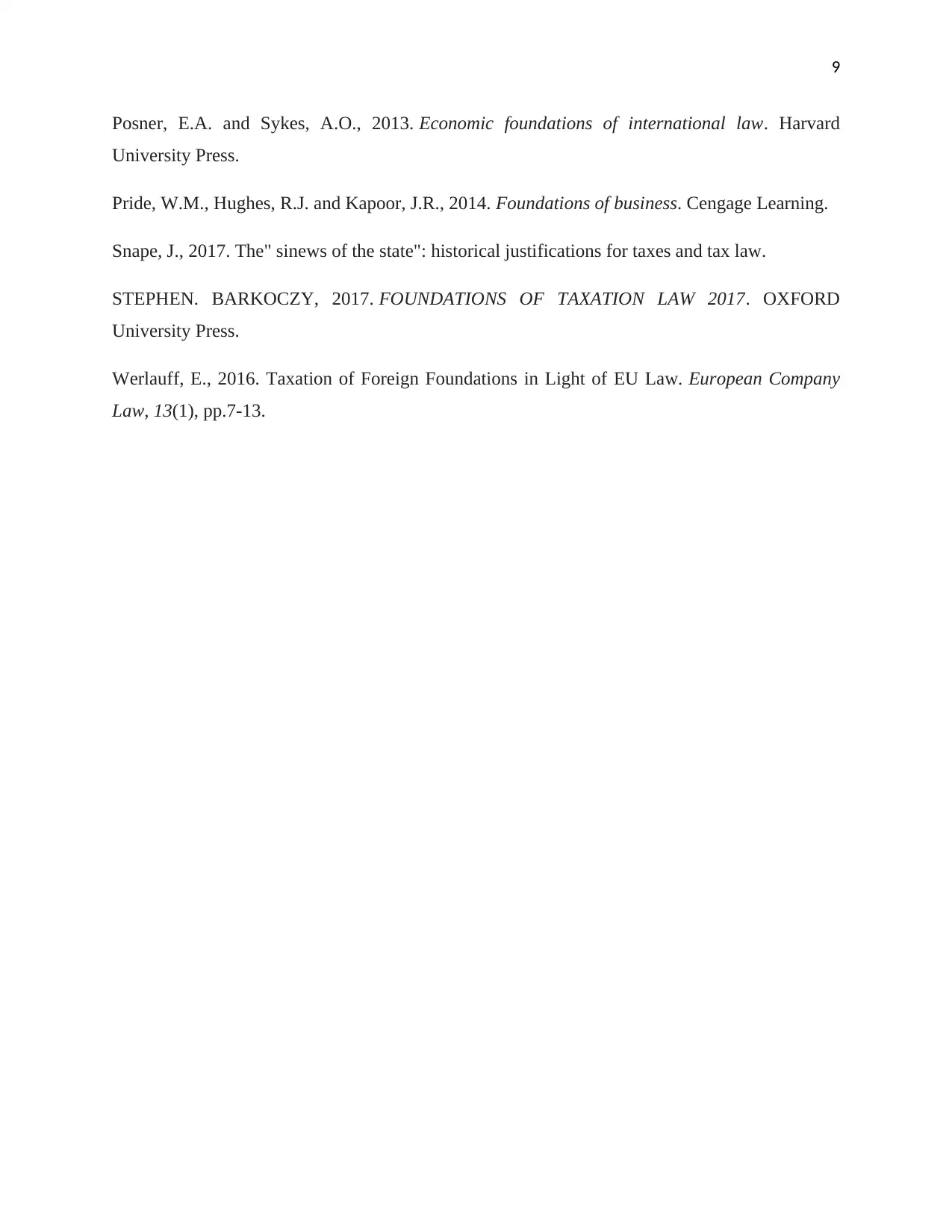
9
Posner, E.A. and Sykes, A.O., 2013. Economic foundations of international law. Harvard
University Press.
Pride, W.M., Hughes, R.J. and Kapoor, J.R., 2014. Foundations of business. Cengage Learning.
Snape, J., 2017. The" sinews of the state": historical justifications for taxes and tax law.
STEPHEN. BARKOCZY, 2017. FOUNDATIONS OF TAXATION LAW 2017. OXFORD
University Press.
Werlauff, E., 2016. Taxation of Foreign Foundations in Light of EU Law. European Company
Law, 13(1), pp.7-13.
Posner, E.A. and Sykes, A.O., 2013. Economic foundations of international law. Harvard
University Press.
Pride, W.M., Hughes, R.J. and Kapoor, J.R., 2014. Foundations of business. Cengage Learning.
Snape, J., 2017. The" sinews of the state": historical justifications for taxes and tax law.
STEPHEN. BARKOCZY, 2017. FOUNDATIONS OF TAXATION LAW 2017. OXFORD
University Press.
Werlauff, E., 2016. Taxation of Foreign Foundations in Light of EU Law. European Company
Law, 13(1), pp.7-13.
⊘ This is a preview!⊘
Do you want full access?
Subscribe today to unlock all pages.

Trusted by 1+ million students worldwide
1 out of 9
Related Documents
Your All-in-One AI-Powered Toolkit for Academic Success.
+13062052269
info@desklib.com
Available 24*7 on WhatsApp / Email
![[object Object]](/_next/static/media/star-bottom.7253800d.svg)
Unlock your academic potential
Copyright © 2020–2025 A2Z Services. All Rights Reserved. Developed and managed by ZUCOL.





